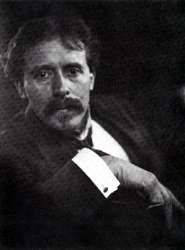
CHARLES ROBERT ASHBEE, 1863 - 1942
Son of a rich businessman and owner of a celebrated collection
of pornography, Ashbee went to Cambridge, where he came under
the influence of Edward Carpenter. He then went to Toynbee
Hall, a philanthropic mission in the East End of London, where
he set up the School and Guild of Handicraft in 1888. The
Guild made woodwork, leatherwork, metalwork and jewellery,
showing at the Arts and Crafts Exhibition Society from 1889.
In 1898 the Guild executed the furniture for Baillie Scott’s
schemes for the Darmstadt Palace of the Grand Duke of Hesse.
The Guild’s work was shown at the 1900 Vienna Secession
Exhibition. In 1901 Ashbee moved to Chipping Camden in Gloucestershire,
taking some 150 people - Guildsmen and their families - with
him. The Guild’s finances were overstretched and the
venture failed in 1907. Ashbee had made contact with Frank
Lloyd Wright when he visited America in 1896, and kept up
with him later. He also admired the architecture of the brothers
Charles Sumner and Henry Mather Greene.
MACKAY HUGH BAILLIE SCOTT, 1865 - 1945
After serving his articles in Bath, Baillie Scott began his
career in Douglas, Isle of Man. There he came into contact
with Archibald Knox and collaborated with him on the design
of stained glass and metalwork. He exhibited furniture, metalwork
and wallpaper at the 1896 Arts and Crafts Exhibition, the
year in which he deigned the ‘Manxman’ piano case.
The commission from the Grand Duke of Hesse to decorate rooms
in the palace at Darmstadt came in 1898. In 1901 he gained
the highest award for his entry in Inmen-Dekoration competition
for the ‘House for and Art Lover’. He had moved
to Bedford in 1901, and from there he conducted a successful
practice in suburban homes, which gained greatly from his
partnership with A. Edgar Beresford.
WILLIAM ARTHUR SMITH BENSON, 1854 - 1924
Educated at Winchester and Oxford, Benson served his articles
in the office of Basil Champneys and remained in the practice
until 1880. He had met with Morris through his friendship
with Edward Burne-Jones, and was inspired to set up a metalworking
workshop in that year. He expanded into a well equipped factory
in Hammersmith and from 1887 had a retail shop in Bond Street.
In 1896 he became chairman of Morris & Co., for which
he designed furniture. He also worked for J.S.Henry and the
Coalbrookdale and Falkirk iron foundries. Benson’s simple
well designed and utilitarian copper and brass tablewares,
jugs and lighting equipment were praised by H. Muthesius.
Bing chose his work for exhibition and sale at his Paris gallery,
Maison de L’Art Nouveau. Benson was an active member
of the Art Workers’ Guild and in 1914 founder of the
Design and Industries Association. He retired and the firm
was bought by Allen-Liversedge Ltd, a lighting company, in
1920.
 SIR
EDWARD BURNE-JONES, 1833 - 1898 SIR
EDWARD BURNE-JONES, 1833 - 1898
Burne-Jones met William Morris at Oxford and became his lifelong
friend and longest collaborator. They set up house together
in Red Lion Square and one of the earliest pieces of painted
furniture, Morris’ most conspicuous contribution to the
early production of his firm, was a wardrobe designed by Phillip
Webb and painted by Burne-Jones with an episode from Chaucer’s
‘Prioress’ Tale’. In 1857 Burne-Jones started
designing stained glass for Powell’s of Whitefriars,
he also worked for Lavers and Barraud; from the founding of
the Morris firm in 1861 he was continually occupied with stained
glass designs, tiles, gesso-work, embroideries and tapestries
for them, which he consistently complained of as ill-renumerated.
One of the last tasks for Morris was the fifty seven illustrations
for the Kelmscott Chaucer (1895), completed when Morris was
already mortally ill.
WILLIAM FREND DE MORGAN, 1839 - 1917
From 1861 De Morgan was involved with stained glass design;
in 1863 he began concentrating on ceramics, designing tiles
for William Morris, alongside Simeon Solomon and Albert Moore,
his contemporaries at the Academy Schools. His orange House
pottery at Cheyne Row in Chelsea started production in 1873;
in 1882 he moved with Morris to Merton Abbey. He worked at
the Sands End pottery in Fulham from 1888-98 in partnership
with the architect Halsey Ricardo. He continued the Sands
End pottery until 1907 when he turned to writing novels; his
partners from 1898, Charles and Fred Passenger and Frank Iles,
kept the pottery in production until 1911. De Morgan made
a significant contribution to the Art Pottery movement with
the revival of lustre techniques; among his contemporaries
in this field he most admired the work of the Frenchman Clement
Massier and the Cantagalli factory in Florence. Although De
Morgan’s wife claimed there was no commercial collaboration
between Cantagalli and De Morgan, they did make pieces to
each other’s designs.
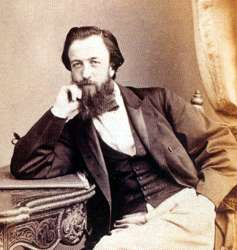 CHRISTOPHER
DRESSER, 1834 - 1904 CHRISTOPHER
DRESSER, 1834 - 1904
Dresser was born in Glasgow, and from 1847 to 1854 studied
at the Government School of design, Somerset House, where
he was awarded a prize for a fabric design which was put into
production by Liddiard and Co. He lectured on botany at the
school before going on as a lecturer to the Department of
Science and Art at South Kensington, specialising in botany.
In 1856 he supplied a plate depicting the ‘geometrical
arrangement of flowers’ for Owen Jones’ ‘Grammar
of Ornament’. The Art Journal published a series of his
lectures on ‘Botany as adapted to art and manufactures’
in 1857 and 1858, and in 1859-60 he wrote several books on
botany and plant morphology, gaining a doctorate from the
University of Jena in 1860. By 1862 he had established a studio
of pupils at Chiswick and supplied a number of designs at
the London International Exhibition. Dresser made drawings
and purchases from Sir Rutherford Alcock’s collection
of Japanese art, shown at the exhibition. In the same year
his first design book was published: The Art of Decorative
Design. Ceramics for Minton and Wedgwood, and carpets for
Brinton’s were shown in Paris in 1867, metalwork for
Coalbrookdale at London in 1871, and designs for eleven wallpaper
companies exhibited at Paris in 1878. In 1876 Dresser visited
the Philadelphia Exhibition, en route to Japan at the invitation
of the Japanese Government, to report on their art industries.
He brought with him many gifts from the South Kensington Museum
for the Emperor, and acted as a buying agent for Londos &
Co. and Tiffany and Co. In 1879 he established Dresser and
Holme, with the later editor of the Studio, importing Oriental
goods; and Linthorpe Pottery, for which he provided radical
new designs. His designs for metalwork for Hukin and Heath,
first shown in 1879, James Dixon and Sons, and Elkington (for
whom he had worked since the 1860s) reflected his Japanese
experience in their simplicity. He established the Art Furnishers’
Alliance in 1880; worked as art editor at the Furniture Gazette
from January to December 1881; and in 1882 published ‘Japan,
It’s Architecture, Art and Art Manufactures’. After
the collapse of the Alliance in 1883 Dresser moved to Sutton,
Surrey, before returning to Barnes in 1889. He supplied designs
to at least fifty companies, both in Britain and overseas.
An anonymous article in ‘The Studio’ (1899) described
him as ‘perhaps the greatest of commercial designers’.
Studies in Design by Christopher
Dresser
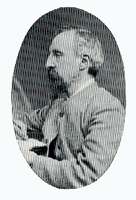 EDWARD
WILLIAM GODWIN, 1833 - 1886 EDWARD
WILLIAM GODWIN, 1833 - 1886
Born in Bristol, Godwin intended training as a civil engineer
and was articled to William Armstrong, a local architect-cum-engineer
and friend of Isambard Kingdom Brunel. He set up his own office
in 1854 and travelled to Ireland to assist his brother, also
a civil engineer, with a design for a railway bridge. He met
Burges in 1858 and they became good friends, visiting Ireland
together in the 1860s when Godwin began Dromore and Glenbeigh
Towers. His first major commission, Northampton Town Hall
(1861), was based on Ruskin’s ‘Stones of Venice’.
His designs for furniture and decoration were carried out
by Green and King, London, and stained glass was supplied
to Heaton, Butler and Bayne. Godwin was among the group who
made purchases of Japanese objects after the 1862 exhibition,
and he became very influenced by Japanese culture. His designs
for applied art included furniture for the Art Furniture Co.
and later William Watt, W. Smee, Cox and Son, Gillow’s,
Waugh & Co., C. Greaves, James Peddle, and Collinson and
lock, by whom he was paid a retainer from 1872 - 1874; wallpapers
for Jeffrey & Co.; fabrics for Warner and Ramm; ceramics
and tiles for Brownfield, Minton, Hollins & Co. and Wilcock
& Co.; and metalwork for Messenger and Co. and Jones and
Willis. During his affair with Ellen Terry, Godwin wrote a
series of articles on theatrical scenery and costume, became
increasingly interested in dress design, working at Liberty’s
dress department from 1884. Godwin also wrote articles on
Japanese art, Celtic and Saxon architecture, and contemporary
issues for the ‘British Architect, the Architect and
Building News’ In 1875 Godwin left Ellen and their two
children, and soon after married Beatrice Philip, who became
a pupil of his friend Whistler, with whom he had collaborated
on the furniture for Watt at the 1878 exhibition. After Godwin’s
death Beatrice married Whistler. He built Whistler’s
controversial White House on Tite Street, Chelsea, and helped
Oscar Wilde decorate his house in the same street in 1884.
William Burges, J.P.Sedding, Peter Paul Pugin, H.Crisp, R.W.Edis,
M.B.Adams and J.M.Bryndon were amongst his circle of friends
and partners.
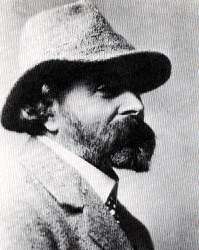 ARCHIBALD
KNOX, 1864 - 1933 ARCHIBALD
KNOX, 1864 - 1933
Born on the Isle of Man, Knox studied at the Douglas School
of Art where he subsequently taught. He worked with H.M. Baillie
Scott before coming to London in 1897, where he designed for
the Silver Studio; in the following year he started his long
association with Liberty’s. Knox was principally responsible
for the singularly original character of Liberty’s two
metalworking ventures, the ‘Cymric’ silver and jewellery
and the ‘Tudric’ pewter wares, but he also designed
carpets and textiles for them. The association lasted until
1912, but Knox’s designs had already been sold to James
Connell & Co. in 1909. From 1912 he designed carpets for
Bromley & Co. of Philadelphia. After the First World War
he painted and taught.
LIBERTY & CO., 1875 to present
Arthur Lasenby Liberty (1843-1917) established his firm as
an Oriental warehouse, and soon built it into a household
word for artistic decoration and furnishing. Much of the early
furniture stock was imported or locally made ‘Anglo-Oriental’
bamboo furniture. From 1883 the Furnishing and Decoration
studio was run by Leonard Wyburd. After the failure of the
Art Furnishers’ Alliance, of which he was a shareholder,
Liberty took out patents for the two versions of the ‘Thebes’
stool, which was to become one of the most popular products
of the furniture studio. Furniture was supplied by wholesale
companies such as William Birch and J.S.Henry, who made designs
by George Walton, and the firm also stocked chairs designed
by the German Richard Riemerschmid (1868-1957). The dress
department was under the direction of E.W. Godwin. From 1898
Liberty’s started to import German pewter from J.P.Kayser
und Sohn among others, and in the following year they began
their own metalworking venture using such designers as Archibald
Knox, Oliver Baker and john Pearson, who had worked with C.R.
Ashbee, 1888-92. These along with C.F.A. Voysey, Walter Crane,
L.F.Day and the Silver Studio put the firm into the mainstream
of Art Nouveau. Textiles were supplied by Thomas Wardle, who
had made Morris’ early prints, and by G.P. Baker and
Morton & Co. Liberty’s stocked Donegal carpets by
Voysey; enamels by C.J. Heaton; art pottery by Brannam, Doulton,
Moorcroft, Compton and other European potteries such as Max
Lauger, which made designs especially for Liberty; as well
as amateur work by the Home Arts and Industries Association;
and Clutha glass by Dresser and Walton. Many other ‘Art
Manufacturers’ were represented and their products are
illustrated in the gift and furniture catalogues from the
1890s.
Directory of Liberty Manufacturers
CHARLES
RENNIE MACKINTOSH, 1868 - 1928
Born in Glasgow, Mackintosh was apprenticed in 1884 to a
local architect, John Hutchinson. He entered the office of
Honeyman & Keppie in 1889, and there became friendly with
a fellow draughtsman, J. Herbert MacNair. From about 1896
Mackintosh was designing furniture for Messrs Guthrie &
Wells of Glasgow. In 1897 he won the competition to design
the new Glasgow School of Art. In the same year Mackintosh
received the first of the Cranston Tea Rooms commissions,
working on the decoration of the Buchanan Street premises
in collaboration with George Walton, who made some of his
early furniture. In 1900 he participated by invitation in
the Vienna Secession Exhibition, and he was responsible for
the Scottish section at Turin in 1902. He married Margaret
Macdonald in 1900. Important individual projects included
Windyhill for Walter Blackie (1899), the Warndorfer Music
Room (1902), Hill House (1903) and the second stage of the
Glasgow School of Art (1906), as well as a number of commissions
from the Misses Cranston. Mackintosh left Glasgow in 1914.
Apart form one or two architectural projects, including work
for W.J. Bassett-Lowke, he concentrated mainly on watercolour
painting and textile designs for Foxton’s and Sefton’s.
His designs were well illustrated in European periodicals.
Charles Rennie Mackintosh:
A Pictorial History
 WILLIAM
MORRIS, 1834 - 1896 WILLIAM
MORRIS, 1834 - 1896
Born into a wealthy family in Walthamstow and educated at
Marlborough and Exeter College, Oxford, where he met his life
long friend Edward Burne-Jones, Morris entered G.E. Street’s
architectural office in 1856 where Phillip Webb was senior
clerk. He founded the co-operative firm of Morris, Marshall,
Faulkner & Co. on the suggestion of Ford Madox Brown in
1861. It remained a partnership until Morris took sole proprietorship
in 1875, changing the name to Morris & Co., and introducing
an extensive range of textiles and wallpapers many of which
he designed. In 1878 he moved his family to Kelmscott House
in Hammersmith where he began the manufacture of hand knotted
carpets. In the search to improve the quality of the firm’s
manufactures Morris moved his works from London to Merton
Abbey Mills in 1881. Here there was now room to manufacture
carpets and tapestries that had previously only been possible
on an experimental scale. From 1870 Morris had been interested
in illuminating manuscripts and planned publication of his
own poems, but it was not until 1891 that he set up the Kelmscott
Press for which he designed three typefaces. It produced 53
books before closing in 1898. Morris was a founder member
of the Society for the Protection of Ancient Buildings in
1877. During the 1870s Morris became involved with politics
and from 1883 with the Socialist Democratic Federation. He
was a founder member of the Socialist League and editor and
financier of the ‘Commonweal’. Morris died in Hammersmith
after a prolonged illness.
William Morris - A Pictorial
History
MORRIS & CO, 1861 - 1940
Founded as Morris, Marshall, Faulkner & Co., by William
Morris in 1861, the firm exhibited for the first time in London
in 1862. Commissions followed for the South Kensington Museum
and St. James’s Palace, as well as for stained glass
and private decorating work. Morris became the sole director
in 1875, when the firm was renamed Morris & Co. Retail
premises in Oxford Street were opened in 1877. With the acquisition
of Kelmscott House in Hammersmith in 1878 Morris was able
to set up carpet looms. In 1881 he expended into weaving and
dyeing workshops at Merton Abbey. Morris’ last venture,
the Kelmscott Press, was also housed in Hammersmith. At Morris’
death in 1896 W.A.S. Benson took over the directorship of
the firm. In the 1920s the showrooms were transferred to George
Street, and in 1940 the business closed.
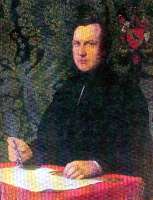 AUGUSTUS
WELBY NORTHMORE PUGIN, 1812- 1852 AUGUSTUS
WELBY NORTHMORE PUGIN, 1812- 1852
Trained as a draughtsman with his father’s pupils, Pugin
embarked on a design career as early as fifteen years
of age, with Gothic furniture to be made by Morel and
Seddon for Windsor Castle and metalwork for the Royal
goldsmiths Rundell, Bridge & Co. His numerous publications
were highly influential; his Reformed Gothic ecclesiastical
and domestic buildings set the pattern for the Gothic
Revival in England for two decades; his work on the
interior of the New Palace of Westminster initiated
many patterns and techniques that found their way into
the commercial repertory of domestic design. His early
stained glass was made by Wailes but from 1845 he used
Hardman & Co., who were already making his designs
for metalwork, silver and embroideries. Pugin worked
with his manufacturers, encouraging the introduction
of new products and techniques. His closest allies,
Hardman, Crace, Myers and Minton, began to plan their
contribution to the Great Exhibition in March 1850.
A number of their exhibits for the resulting Medieval
Court were chosen by the purchasing committee for the
new South Kensington Museum, on which Pugin sat with
Henry Cole, and Richard Redgrave. His crowded career
came to an end with his mental collapse and he died
insane aged only forty.
www.pugin.com
Floriated Ornament by A.W.N.
Pugin c.1849
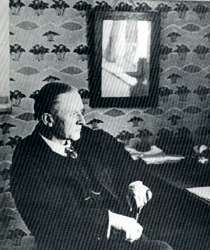 CHARLES
FRANCIS ANNESLEY VOYSEY, 1857 - 1941 CHARLES
FRANCIS ANNESLEY VOYSEY, 1857 - 1941
Articled to J.P. Seddon, Voysey worked for G. Devey in 1880,but
at the outset of his own career turned to decorative design
while waiting for his architectural practice to gain momentum.
He joined the Art Workers Guild in 1884 and exhibited with
the Arts and Crafts Exhibition Society from 1888. He designed
the cover for the first volume of ‘The Studio’ magazine
in 1896. Voysey had a great talent for pattern making and
designed wallpapers for Jeffrey & Co. and Essex &
Co.; textiles for Alexander Morton; tiles for Pilkington’s
and later Minton’s; and carpets sold through Liberty.
From the mid 1880s he experimented with furniture, much of
which was made by F.C. Nielson, in a severe, distinctive,
vernacular influenced manner using oak. His large table clock,
with versions in plain aluminium, painted wood and polished
oak, is one of his most original pieces. Hi also designed
tablewares, cutlery, metalwork and lighting made by Thomas
Elsley & Co. Although Voysey carried out no public architectural
commissions, publication of his designs gave him an international
reputation.
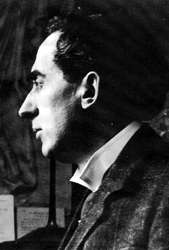 GEORGE
WALTON, 1867 - 1933 GEORGE
WALTON, 1867 - 1933
Son of a painter, Walton initially worked as a bank clerk
and attended evening art classes. His brother E.A. Walton
was one of the ‘Glasgow Boys’. George Walton &
Co, Ecclesiastical and House Decorators, was established in
Glasgow in 1888 as a result of a commission to decorate a
new smoking room in one of Miss Cranston’s Tea Rooms.
Walton showed with the Arts and Crafts Exhibition Society
in 1890, and in 1892 designed the frames and interior for
his friend J.Craig Annan’s second photography exhibition.
Annan later bought shares in Walton’s company. In 1896
Walton received a further commission from Miss Cranston, to
decorate her Buchanan Street premises. His collaborator was
C.R. Mackintosh, for whom Walton made some early pieces of
furniture. In 1897 Walton moved to London and, as well as
retaining his Glasgow showroom, opened a branch in York. Walton’s
decoration of Annan’s home and exhibitions and his subsequent
introduction to the Linked Ring - a group of photographers
founded to promote photography as art - led to many commissions,
including a design for the cover of ‘Practical Photography’.
Despite having no formal architectural training he built a
number of houses including The Leys, Elstree, in 1901 for
J.B.B. Wellington, the manager of Kodak at Harrow; and in
1907 the White House and a houseboat, the Log Cabin, for G.
Davidson, the retired managing director of Kodak Great Britain.
He was retained by the Kodak Company to decorate showrooms
in London, Glasgow, Brussels, Milan and Vienna, and his designs
were illustrated by Herman Muthesius in ‘Dekorative Kunst’.
Walton designed for James Couper’s range of ‘Clutha’
glass, furniture made by J.S. Henry for Liberty, wallpapers
for Jeffrey & Co., textiles for Alexander Morton, and
carpets. The later years of his career were spent as architect
to the Liquor Control Board.
 PHILIP
WEBB, 1831 - 1915 PHILIP
WEBB, 1831 - 1915
Webb met William Morris in G.E. Street’s office in Oxford.
His subsequent architectural practice as well as his design
career were bound up in the fortunes of the Morris firm. Commissions
for both were interdependent, Webb specifying the Morris firm
as decorators and Morris recommending Webb as architect. Webb
was responsible for the decorative scheme in an early Morris
commission, the ‘Green Dining Room’ at the South
Kensington Museum (still intact and recently restored by the
Victoria and Albert Museum) and drew almost all the birds
and animal’s in Morris’ fabric, tapestry and wallpaper
designs. He was commissioned by Morris to design table glass
by Powell’s and furniture for the Red House in 1859.
Webb provided furniture designs for Major Gillum in 1860 and
for the Morris firm in 1861 until the responsibility was taken
over by his assistant George Jack in the 1880s. Metalwork
for gates and fireplaces was executed by Longden, whose London
premises were next to Morris & Co.’s showrooms. He
used he distinguished carver James Forsyth, who had also worked
for R. Norman Shaw, his successor in Street’s office,
and W.E. Nesfield among others. Webb retired in 1900, unable
to come to terms with what he foresaw as the future of architecture.
Shaw described him as ‘A very able man indeed, but with
a strong liking for the ugly’.
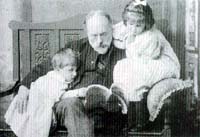 Frederick
William Burton Frederick
William Burton
Born in County Clare, Ireland, in 1816, Burton was the son
of an amateur artist. He studied in Dublin and exhibited his
first watercolour at the RHA in 1832. As a student he mixed
with the leading intellectuals of the time, and developed
an interest in the Irish landscape and the customs and dress
of its people. In 1851 he left Ireland for Germany and spent
the next seven years there employed by Maximillian II of Bavaria.
During this time he became inspired by the work of the Old
Masters. He then settled in London where he was appointed
Director of the National Gallery, a post which he held for
twenty years. In 1864 he painted his masterpiece The Meeting
on the Turret Stairs an illustration of an episode from a
Danish Ballad. On his death in 1900 he was taken back to Dublin
to be buried.
W. G. TARRANT
'WG Tarrant: Master Builder and Developer' by Mavis Swenarton. First published as Monograph 24 by the
Walton and Weybridge Local History Society.
Read full article
Sir John Everett Millais
Born in Southampton, England 1829. With Hunt and Rossetti,
Millais founded the Ore-Raphaelite Brotherhood. He had amazing
technical virtuosity but he was not attached to intellectual
dogma like Hunt and gradually drifted away from his early
ideals. He started to create works for the popular market
and by1875 was earning around £30,000 p.a. from his work.
In Ophelia there is an intricate detail in every weed and
flower and it is said that the model lay in the bath for hours
on end with only candles to warm the water, and she later
died of pneumonia. Millais became a baronet in 1885 and on
the death of Lord Leighton became president of the Royal Academy
in 1896, only to die a few months later in London, 1896.
John William Waterhouse
Born in Rome, Italy in 1849, Waterhouse s early work was influenced
by Alma-Tadema, and he later became an associate of the Pre-Raphaelites,
although his work differed widely from that of the original
Brotherhood in its lack of moral seriousness. In particular
he devoted his time to classical subjects and the femmes fatales
of literature. His paintings were mainly of women: men were
usually depicted as victims, as in Hylas and the Nymphs .
The Lady of Shalott was one of his first successes, capturing
a romantic, dreamy mood in a highly naturalistic setting.
The Danaides , in Greek Mythology, were commanded to murder
their husbands on their wedding night. All but one obeyed
and they were punished by having to draw water from a well
and pour it into a vessel from which it continually escaped.
Penelope and her Suitors , commissioned by the Aberdeen Art
Gallery, was an expensive and controversial purchase. This
great Victorian romantic painter, a quiet and modest man,
successfully pulled together the opposing late Victorian Subjects
of the Pre-Raphaelites and Classicism. He died in London 1917.
Sir Lawrence Alma-Tadema
Alma-Tadema was born in Holland in 1836 and after studying
art in Antwerp, worked for Professor Louis de Taye, a famous
archaeologist, later studying Roman and Pompeiian ruins. Thus
his re-creation of antiquity was based on profound knowledge.
Finding a ready market amongst the English for his classical
scenes, he settled in London in 1870 and became one of the
most successful Royal Academicians. He was especially noted
for his ability to reproduce the effect of sunlight on marble
and the sparkle on water. He died in 1912.
Sir Edward Coley Burne-Jones
Burne-Jones was born in Birmingham. He enrolled at Exeter
College, Oxford intending to enter the church (an idea he
later abandoned) and there met William Morris. In 1856 he
first met Rossetti who was to greatly influence him. In 1860
he was an active member of Morris and Co., for whom he produced
many tapestry and stained glass designs. Both these and his
paintings evoke a dreamy, romantic feel which is strongly
associated with the second phase of Pre-Raphaelitism. Both
The Sleeping Beauty and Cupid and Psyche feature sleeping
women: sleep, dreams and states of trance like stillness are
frequent in Burne-Jones work and must have exercised a compelling
fascination for him. He was made a baronet in 1864.
Conrad Keisel
Born in Dusseldorf 1846. He lived and worked in Berlin, where
he won gold medals in 1889-1890, and in Munich. He died in
1921.
Charles Rennie Mackintosh
Born in 1868 in Glasgow, Mackintosh trained as an architect
at a local firm and took evening classes in art and design
at the Glasgow School of Art. Here he met his wife, the artist
Margaret Macdonald, and they formed a group of designers,
developing a distinctive style reminiscent of Aubrey Beardsley
and inspired by the Continental Art Nouveau movement. Mackintosh
undertook several commissions at this time including the new
Glasgow School of Art. However his style was never truly appreciated
in Glasgow and the Mackintoshes left to enjoy great success
and influence in Europe. They returned to England in 1914
and settled in Suffolk where Mackintosh painted many delicate
flower studies, but a year later they moved to London. Here
Mackintosh resumed work as an architect and designer producing
some of his best and most original work, using geometric motifs
and primary colours. However, this extraordinary output of
work was scarcely recognised in the UK, and in 1923 they moved
to the South of France, where Mackintosh gave up architecture
and devoted himself totally to painting landscapes. He died
in 1928.
Charles-August Mengin
Born in Paris in 1853. Mengin was a pupil of Cabanel and was
a sculptor as well as a painter. Exhibited regularly at the
Paris Salon from 1876-1927. Sappho was a much-admired Greek
lyric poetess, who taught the arts on the Greek island of
Lesbos. This dramatically sensual portrait shows Sappho with
her lyre on the Leucadian rock, moments before she jumps to
her death, according to legend. Died 1933.
Dante Gabriel Rossetti
Rossetti was a poet and painter, born in London 1828, the
son of an Italian political refugee and the brother of Cristina
Rossetti. In 1848 he formed the Pre-Raphaelite Brotherhood
together with Holman Hunt and Millais, however, their association
was short since Rossetti s romantic imagination set him apart
from the more literal endeavours of the others. His subjects
were mostly drawn from Dante and from a mediaeval dream world
which was also reflected in his poems. Died 1882.
John Melhuish Strudwick
Strudwick worked as a studio assistant to both Spencer Stanhope
and Burne-Jones and his style reflects the influence of both.
His subjects are usually poetic and allegorical. He was an
admirer of Italian Renaissance painting and his pictures reflect
this. One of the first writers on Strudwick s work was the
young Bernard Shaw who wrote an article on him in 1891 praising
his transcendent expressiveness .
|